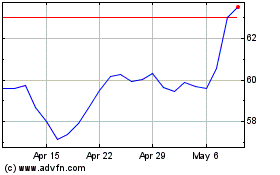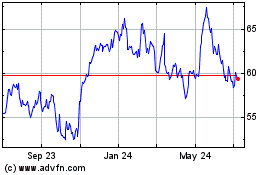By Suzanne Vranica
What do comedian Amy Schumer, an overly active fetus and the
singer Seal have in common? Each appeared in commercials Sunday
during Super Bowl 50 that scored big with viewers.
Bud Light, which ran a funny election-themed ad featuring Ms.
Schumer and actor Seth Rogen enlisting supporters to join the "Bud
Light Party," seems to have gotten its marketing mojo back,
according to advertising executives and consumers surveyed by The
Wall Street Journal.
"Well done and great casting," said Ewen Cameron, co-founder of
ad agency Berlin Cameron United.
Getting Bud Light's advertising back on track is critical for
parent company Anheuser-Busch InBev, the world's largest brewer.
Bud Light sales have struggled for more than a year and the brand
has had trouble finding the right marketing message. Wieden &
Kennedy created the spot for the big game.
"Nice to see Bud Light come back," said Mike Duda, managing
partner at Bullish, another creative agency.
"Awesome Bud Light ad," said Tyler Piluzza, a 31-year-old
fashion designer from Newport Beach, Calif.
The National Football League--which has been dealing with
controversies that include concussions, domestic violence and the
air pressure of footballs--hit a high note during the game with an
ad that shows babies, children and adults, who were born nine
months after their parents' favorite teams won the Super Bowl,
singing Seal's "Kiss from a Rose."
"The spot has universal appeal and makes you feel good," said
Courtney Doyle, a partner at Connelly Partners. The ad was crafted
by WPP PLC's Grey.
Meanwhile, perennial fan favorite Doritos got viewers laughing.
Its spot, created by a consumer, featured a pregnant woman getting
a sonogram and the fetus can be seen trying to get dad's Doritos.
The PepsiCo Inc. snack brand "owns shock" advertising, said Chris
Becker, chief executive officer of Gyro.
"Doritos was the most clever ad, said John Brown, a 51-year old
real-estate agent in Philadelphia.
All three winning spots featured in the defense-heavy title game
where the Denver Broncos defeated the Carolina Panthers had
something in common: humor.
The lighter tone was a marked departure from last year's ad
contest that experts said was weighed down by too many companies
airing overly emotional ads, or spots that tackled heavy issues
such as cyberbullying and gender stereotyping.
"Humor brings people together, even if it's a smile and not a
big laugh, " said Allen Adamson, a branding consultant. "Heavier
social issues" can be "polarizing."
The notable exception during the game included several
pharmaceutical ads that touched on uncomfortable topics such as
irritable-bowel syndrome, constipation and toe-nail fungus.
Super Bowl ads remain a powerful cultural phenomenon year after
year, regardless of the changes in the media landscape or people's
attitudes toward TV ads in general.
These days, anti-advertising sentiment is running particularly
high. Young viewers are being drawn to streaming video services
such as Netflix and Amazon, in part because they don't show ads.
Some Web users are turning to ad blockers to escape the onslaught
of marketing messages.
Many of those concerns, however, seem to melt away for a day
each February.
Indeed, the excitement starts even before the big game. Last
week, 11.4 million viewers tuned in to CBS to watch "Super Bowl
Greatest Commercials 2016"--an entire show about ads from past NFL
title games. That is more viewers than many prime-time programs
get.
For advertisers, the stakes on Super Bowl Sunday are enormous.
Not only are 100 million-plus viewers likely watching, but the
Super Bowl is the priciest real estate on TV, with 30-second spots
costing as much as $5 million this year. That doesn't include the
millions that some of the advertisers spend to create and publicize
their big-game ads.
Yes, ads for an ad.
Marketers have spent an estimated $11.9 million on national TV
ads during the past few weeks to tease their Super Bowl
commercials, according to ad-tracker iSpot.tv.
Still, not every ad lived up to the hype. Spots from online
lender Social Finance Inc. (SoFi), SunTrust Banks Inc., and a spot
from AstraZeneca that talked about opioid-induced constipation,
missed the mark, according to ad executives and consumers.
"It's weird to have a constipation ad in the Super Bowl," said
Margie Truwit, a 26-year-old law student from Chappaqua, NY.
SoFi's ad, which showed shots of random people doing everyday
tasks as a narrator points out if the person is "great" or "not
great," was slammed for being mean spirited. The spot was
"elitist," said Mark DiMassimo, chief executive officer of the
agency DiMassimo Goldstein. "Brands calling people 'not great,' is
not great," he added. "Too judgmental," said Carla Mote, managing
partner at Red Tettemer O'Connell + Partners.
"I didn't like that one, it was too critical," said Steve
Morgan, a 51-year-old financial adviser from Corte Madera,
Calif.
The ad drew criticism despite an attempt by SoFi, whose $4
billion valuation makes it one of Silicon Valley's so-called
unicorns, to make the ad less controversial.
Days before the Super Bowl, SoFi cut the final line from its ad
after noticing some negative comments on social media. The spot
originally ended with a line that said: "Find out if you're great
at SoFi.com; you're probably not." In the updated version, the
company cut "you're probably not."
SunTrust Banks, which had never aired a national TV ad before
this Super Bowl, also came up short. Its spot, which highlighted
how it feels to be under financial pressure and how SunTrust can
help, was depressing, said ad executives who were polled.
"That ad should run on early morning news programming, not while
you are eating chicken wings watching the Super Bowl," said Pierre
Lipton, chief creative officer at digital ad firm 360i.
Ads from Mountain Dew, Amazon.com Inc., and Coca-Cola Co., which
featured Marvel characters Ant-Man and the Hulk in its spot, are
expected to generate plenty of postgame buzz, ad executives
said.
A PepsiCo spot for Mountain Dew Kickstart featured a
freakish-looking creature that was created by combining three Super
Bowl tropes: a puppy, a monkey and a baby.
The spot will play well with millennials, though it will be
"polarizing, " said Kait Strovink, associate creative director at
Publicis Groupe's SapientNitro.
"Puppymonkeybaby was off-putting but my kids laughed
hysterically," said Joshua Schultz, a 41-year-old pharmaceutical
executive in Boston.
Meanwhile, Amazon's spot showing celebrities such as Alec
Baldwin and Missy Elliott using Alexa--the voice-controlled virtual
assistant in Amazon Echo--was praised by ad executives for its
ability to entertain as well as get its product message across
clearly. "It made the technology look really cool," said Ambika
Pai, director of brand strategy at Gyro.
During the past several years, automotive companies have become
the biggest spenders in the Super Bowl. Last year, the category
spent about $97 million on the game and accounted for more than
one-fifth of the ad time in the contest, according to Kantar Media,
an ad-tracking firm owned by WPP.
There was no sign of a letup this year, as brands such as Audi,
Hyundai, Kia, Jeep, Buick, Acura and Mini Cooper competed for
attention, with many enlisting celebrities.
It was a herd of sheep that won over viewers.
Honda Ridgeline's commercial, which highlighted having stereo
speakers in the bed of the pickup truck by showing sheep singing
"Somebody to Love" by Queen, was "well-executed and charming," said
Jonah Disend, chief executive officer of Redscout.
Write to Suzanne Vranica at suzanne.vranica@wsj.com
(END) Dow Jones Newswires
February 07, 2016 23:19 ET (04:19 GMT)
Copyright (c) 2016 Dow Jones & Company, Inc.
Anheuser Busch Inbev SA NV (NYSE:BUD)
Historical Stock Chart
From Mar 2024 to Apr 2024

Anheuser Busch Inbev SA NV (NYSE:BUD)
Historical Stock Chart
From Apr 2023 to Apr 2024
